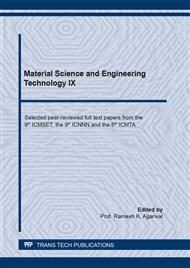[1]
Lavat, A.E., Trezza, M.A., Poggi, M. (2009). Characterization of ceramic roof tile wastes as pozzolanic admixture. Waste Management, 29 (5), 1666–1674.
DOI: 10.1016/j.wasman.2008.10.019
Google Scholar
[2]
Vieira, T., Alves, A., de Brito, J., Correia, J.R., Silva, R.V. (2016). Durability-related performance of concrete containing fine recycled aggregates from crushed bricks and sanitary ware. Materials Design, 90, 767–776.
DOI: 10.1016/j.matdes.2015.11.023
Google Scholar
[3]
Reig, Lucía, M.V. Borrachero, J.M. Monzó, Holmer Savastano, Mauro M. Tashima, and J. Payá. (2015). Use of ceramic sanitaryware as an alternative for the development of new sustainable binders. Key Engineering Materials, 668, 172–180.
DOI: 10.4028/www.scientific.net/kem.668.172
Google Scholar
[4]
Zimbili, O., Salim, W., & Ndambuki M. (2014). A review on the usage of ceramic wastes in concrete production. International Journal of Civil, Environmental, Structural, Construction and Architectural Engineering, 8(1), 91–95.
Google Scholar
[5]
Halicka, A., Ogrodnik, P., Zegardlo, B. (2013). Using ceramic sanitary ware waste as concrete aggregate. Construction and Building Materials, 48, 295–305.
DOI: 10.1016/j.conbuildmat.2013.06.063
Google Scholar
[6]
Mohammadhosseini, H., Lim, N.H.A.S., Tahir, M.M., Alyousef, R., Samadi, M., Alabduljabbar, H., Mohamed, A.M. (2020). Effects of waste ceramic as cement and fine aggregate on durability performance of sustainable mortar. Arabian Journal for Science and Engineering, 45, 3623–3634.
DOI: 10.1007/s13369-019-04198-7
Google Scholar
[7]
Batayneh, M., Marie, I., Asi, I. (2007). Use of selected waste materials in concrete mixes, Waste Management, 27 (12), 1870–1876.
DOI: 10.1016/j.wasman.2006.07.026
Google Scholar
[8]
Manning, D.A.C. Industrial clays: kaolin (china clay), ball clay and bentonite. In: Introduction to Industrial Minerals. Springer, Dordrecht, (1995).
DOI: 10.1007/978-94-011-1242-0_3
Google Scholar
[9]
ASTM C188-17, Standard Test Method for Density of Hydraulic Cement, ASTM International, West Conshohocken, PA, (2017).
Google Scholar
[10]
ASTM C109 / C109M-16, Standard Test Method for Compressive Strength of Hydraulic Cement Mortars (Using 2-in. or [50-mm] Cube Specimens), ASTM International, West Conshohocken, PA, (2016).
DOI: 10.1520/c0109_c0109m-20
Google Scholar
[11]
ASTM C1012 / C1012M-18, Standard Test Method for Length Change of Hydraulic-Cement Mortars Exposed to a Sulfate Solution, ASTM International, West Conshohocken, PA, (2018).
DOI: 10.1520/c1012_c1012m-18
Google Scholar
[12]
ASTM C1260-14, Standard Test Method for Potential Alkali Reactivity of Aggregates (Mortar-Bar Method), ASTM International, West Conshohocken, PA, (2014).
DOI: 10.1520/c1260-01
Google Scholar
[13]
ASTM C618-19, Standard Specification for Coal Fly Ash and Raw or Calcined Natural Pozzolan for Use in Concrete, ASTM International, West Conshohocken, PA, (2019).
DOI: 10.1520/c0618-12a
Google Scholar
[14]
ASTM C311 / C311M-18, Standard Test Methods for Sampling and Testing Fly Ash or Natural Pozzolans for Use in Portland-Cement Concrete, ASTM International, West Conshohocken, PA, (2018).
DOI: 10.1520/c0311-00
Google Scholar
[15]
Bui, P.T., Ogawa, Y., Kawai, K. (2018). Long-term pozzolanic reaction of fly ash in hardened cement-based paste internally activated by natural injection of saturated Ca(OH)2 solution. Materials and Structures, 51, 144.
DOI: 10.1617/s11527-018-1274-0
Google Scholar
[16]
Bektimirova, U., Shon, C.-S., Zhang, D., Sharafutdinov, E., Kim, J.R. (2018). Proportioning and characterization of reactive powder concrete for an energy storage pile application. Applied Sciences, 8, 2507.
DOI: 10.3390/app8122507
Google Scholar
[17]
Shon, C.-S., Kim, Y.-S. (2013). Evaluation of west Texas natural zeolite as an alternative of ASTM class F fly ash. Construction and Building Materials, 47, 389–396.
DOI: 10.1016/j.conbuildmat.2013.04.041
Google Scholar


